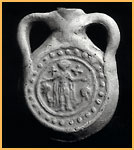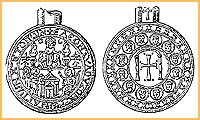|
The pilgrimage complex of St. Menas
Egypt was a significant centre for early Christianity,
with a patriarchate at  Alexandria, burgeoning monasticism in its deserts (which the
fourth-century pilgrim, Egeria, found almost crowded with
monks), and several important shrines, such as that of St
Menas in the Maryut desert, southwest of Alexandria. After
his martyrdom in the early fourth century, Menas acquired
a reputation for miraculous healing powers. His shrine soon
attracted pigrims from around the Christian world. In its
most developed form the church of St Menas consisted of a
complex of three principal structures laid out along an east-west
axis: the pilgrimage church, the so-called Grave Church, and
a
baptistery.
The huge pilgrimage church was a
transept basilica,
similar in plan to that of St John at Ephesus. The Grave Church,
also of basilical plan, was refurbished in the beginning of
the sixth century, when a
tetraconch was
added in its centre, over the presumed burial place of St
Menas. The latter was a catacomb, later transformed into a
stone-built
crypt. The complex
was built of small ashlar and paved in marble, with walls
decorated with polychrome marble revetment, gold figured mosaics
and stuccos.
Alexandria, burgeoning monasticism in its deserts (which the
fourth-century pilgrim, Egeria, found almost crowded with
monks), and several important shrines, such as that of St
Menas in the Maryut desert, southwest of Alexandria. After
his martyrdom in the early fourth century, Menas acquired
a reputation for miraculous healing powers. His shrine soon
attracted pigrims from around the Christian world. In its
most developed form the church of St Menas consisted of a
complex of three principal structures laid out along an east-west
axis: the pilgrimage church, the so-called Grave Church, and
a
baptistery.
The huge pilgrimage church was a
transept basilica,
similar in plan to that of St John at Ephesus. The Grave Church,
also of basilical plan, was refurbished in the beginning of
the sixth century, when a
tetraconch was
added in its centre, over the presumed burial place of St
Menas. The latter was a catacomb, later transformed into a
stone-built
crypt. The complex
was built of small ashlar and paved in marble, with walls
decorated with polychrome marble revetment, gold figured mosaics
and stuccos.
The impressive architectural remains, the lavish materials,
 and
the wealth of surviving pilgrim souvenirs attest to the shrine's
popularity. Earthenware flasks intended as pilgrim souvenirs
were mass-produced at St Menas' shrine, and widely spread
in the Mediterranean region. They contained eulogiai or blessings'
- that is, sanctified substances, such as water from a spring
endowed with miraculous healing properties because of its
proximity to the saint's relics, or oil from a lamp suspended
before the saint's tomb. Pilgrim flasks fulfilled important
amuletic and medicinal functions. Several examples bear stamped
decoration. They usually offer the blessing of Menas, and
picture the saint as a nimbed orant figure flanked by two
camels, which, according to the saint's biography, carried
his dead body to the site of his future shrine. The popularity
of Menas and the potency of the eulogia brought back from
his shrine did much to spread his cult beyond Egypt. Images
of the saint adorn ivory or stone carvings assigned to Constantinopolitan
and Syrian workshops. and
the wealth of surviving pilgrim souvenirs attest to the shrine's
popularity. Earthenware flasks intended as pilgrim souvenirs
were mass-produced at St Menas' shrine, and widely spread
in the Mediterranean region. They contained eulogiai or blessings'
- that is, sanctified substances, such as water from a spring
endowed with miraculous healing properties because of its
proximity to the saint's relics, or oil from a lamp suspended
before the saint's tomb. Pilgrim flasks fulfilled important
amuletic and medicinal functions. Several examples bear stamped
decoration. They usually offer the blessing of Menas, and
picture the saint as a nimbed orant figure flanked by two
camels, which, according to the saint's biography, carried
his dead body to the site of his future shrine. The popularity
of Menas and the potency of the eulogia brought back from
his shrine did much to spread his cult beyond Egypt. Images
of the saint adorn ivory or stone carvings assigned to Constantinopolitan
and Syrian workshops.
A broad range of objects was produced to satisfy the
pilgrims' desire for souvenirs of the holy sites. Flasks similar
to those connected with the shrine of Menas, tokens and medallions
come from a number of shrines around the empire. Several lead
flasks from the Holy Land depict the Grotto of the Nativity
or the Holy Sepulcher. Pilgrim tokens picturing stylite saints
are equally common. St Symeon the Younger (died in 592) spent
many years on top of a column in imitation of the earlier
Symeon, the patron saint of Qal'at Sem'an. Tokens
bearing his image were made from the earth at the base of
the column. According to the saint's biography, one of the
purposes of these tokens was medicinal. When ground to dust
and mixed with water, they formed a paste capable of curing
a range of diseases. They also prevented disasters. A token
was once dissolved and sprinkled over a stormy sea by a monk
called Dorotheos; the miraculous dust calmed the sea at once,
and the monk's life was thus saved. Earthenware pilgrim tokens
were also distributed at Qal' at Sem' an.
|